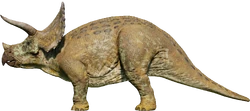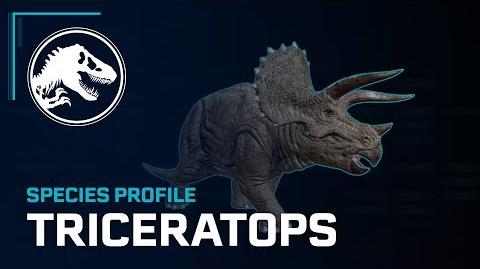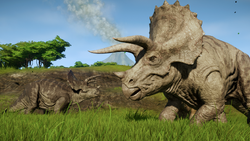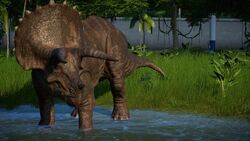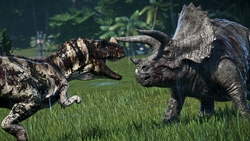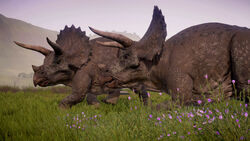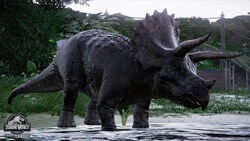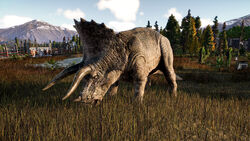| What can be said about the Triceratops? This is one of those dinosaurs that really defines our business. People want to see them, and we want to share them with the world. Don't let that fearsome appearance fool you, those horns are mostly for defence. And impressing other Triceratops. This animal is a herbivore. It can be a star attraction, or a security nightmare if it turns those horns on our fencing. |
Triceratops, or Trike for short, is a genus of ceratopsid dinosaur in the Jurassic World Evolution series. Originating from Late Cretaceous North America, it is by far the largest and most well-known ceratopsian.
In Evolution, Triceratops fossils are first unlocked on Isla Matanceros at the beginning of the main campaign, and are then excavated from the Hell Creek Formation and Lance Formation. In Secrets of Dr. Wu, the Triceratops can be fused with the Stegosaurus to create the Stegoceratops hybrid.
History
During the creation of the original Jurassic Park on Isla Nublar, InGen bred a herd of three Triceratops on the island, one of which died of malnutrition during the incident in 1993.[1] According to a 1993 report, InGen bred a herd of ten individuals on Isla Sorna. Though by the time of the mission to Sorna in 1997,[2] the population count of the species was unknown.[3]
In 1997, Masrani Global purchased InGen and began construction of Jurassic World, which opened to the public in 2004.[4] The herds of Triceratops exhibited in Jurassic World were similar to those originally bred by InGen for Jurassic Park. Three years after the 2015 Isla Nublar Incident, numerous Triceratops roamed free on Isla Nublar.[5]
Following a mission to rescue the dinosaurs from the eruption of Mt. Sibo, several Triceratops were successfully transported to the mainland where they would later be released from captivity into the wilds of northern California.[5]
Four years after the incident in Lockwood Manor, several Triceratops were captured by illegal breeders alongside Sinoceratops and Nasutoceratops, while others were taken to a sanctuary created by BioSyn.[6]
Characteristics
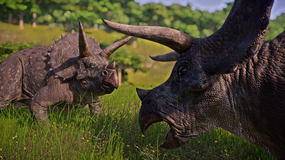
A pair of Triceratops with 1993 skin pattern.
| I see you've hatched a Triceratops. It might be cute now, but that's only going to last for about a week. |
Among the largest of the ceratopsian family, the large bony neck frill and three horns on its head – which give rise to its name translating to "Three-Horned Face" – serve to make Triceratops is one of the most famous dinosaurs in the world, and this makes it a popular attraction. Similar in size to its relatives Pentaceratops and Torosaurus, Triceratops measures between nine and ten meters long and weighs well over eight tons.[7] Triceratops is a herbivore, with its diet consisting mainly of ground level vegetation, although their size may have enabled them to knock over larger plants and trees to feed on. In 2010, a controversial theory was proposed that Triceratops was actually an immature form of Torosaurus, although this has yet to be proven. The base genome for Triceratops is a dirty light brown coloring.
Gameplay
Evolution
Due to being one of the first dinosaurs unlocked in the main campaign of Evolution, Triceratops is among the first dinosaurs released by the player. Due to its low overall requirements and cost, housing these among other herbivores is effective to increasing dinosaur rating. Triceratops lacks the additional trait gene modification slots that other ceratopsians have, meaning it can't be modified to have as high a rating or stats as others in its family.
Behaviour
Triceratops is one of the first available dinosaurs capable of engaging in a death duel. Its low base stats mean that it is highly susceptible to carnivores such as Ceratosaurus, although its moderate social and high population limits will allow it to find safety among a herd.
Triceratops will be content around all other herbivorous species or as a solitary individual. Additionally, Triceratops is also capable of living somewhat peacefully alongside small carnivores such as Troodon and Velociraptor, only occasionally engaging in non-fatal territorial fights.
Triceratops will socialize with others of its own species on occasion, but it otherwise behaves very similarly to other ceratopsians.
Available genomes
| Fossil icon | Dig site | Quality | Number available |
|---|---|---|---|
| Hell Creek Formation | ★ ★★ ★★★ ★★★★ |
1 3 3 3 | |
| Lance Formation | ★ ★★ ★★★ ★★★★ |
1 3 3 3 |
Skins
Evolution 2
Behaviour
In Evolution 2, Triceratops is an adaptable animal, well suited to both a solitary or social existence. Nevertheless, they are highly territorial and do not tolerate other dinosaurs sharing their food source, though will cohabitate and defend their territory alongside certain species of ankylosaurid.[7]
Within a social group, Triceratops are led by a single herd leader, who will lead the defence of the herd against predators or other species which infringe on their territory. Due to their size, Triceratops are rarely attacked by small carnivores, and will stand their ground against larger predators.[7]
Paleontology
The first known Triceratops remains were found in 1887, when George Lyman Cannon found a partial skull with two horns close to Denver, Colorado and sent the specimen to famous paleontologist Othniel Charles Marsh. The bones were initially considered to belong to a large bison but, two years later in 1889, Marsh realized that they belonged to a previously undiscovered genus of horned dinosaur, which he named Triceratops. Fossil remains indicate that it lived across much of North America, sharing much the same territory as Tyrannosaurus.
Growing to measure 30 feet in length and weighing 12 tons, Triceratops is thus far the largest ceratopsian discovered and among the world's most recognizable of all dinosaurs. A member of the Chasmosaurinae branch of ceratopsians, there are two known species in the Triceratops genus: T. prorsus and the holotype T. horridus. Recently, there has been speculation that Torosaurus, a rarer ceratopsian that coexisted with Triceratops, may have been a more mature form of Triceratops, however, this is still under debate. A second species named Nedoceratops, known from only fragmentary remains, is also theorized to be an immature Triceratops.
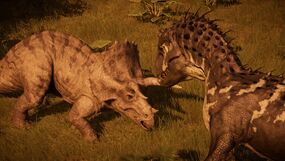
A Triceratops fighting with an Indominus rex.
In real life, Triceratops had a stout, muscular build with longer legs and a shorter tail than what is seen in Jurassic World Evolution. Similar to the in-game Torosaurus, the animal had rows of scutes and bumps along its back. Evidence from more primitive ceratopsians suggests that these may have been anchor points for long quills similar to those found in fossil impressions of Psittacosaurus.
Paleoecology
Triceratops was one of the most common herbivores during Late Cretaceous in United States North America, approximately 83-66 million years ago. Numerous species of dinosaurs lived alongside Triceratops, such as Torosaurus, Edmontosaurus, Ankylosaurus, Pachycephalosaurus, Denversaurus, Leptoceratops, Thescelosaurus, and others. The apex predator of its environment, it's arch-nemesis and the equally famous Tyrannosaurus, was known to hunt and battle Triceratops, with it needing its horns to defend itself from predators. In terms of its environment, it lived and roamed in a range of ecologies, including forests, subtropical inland and coastal regions, and semi-arid plains where food was easy to find.
Behind the scenes
The Triceratops was created using the 3D model that was created for the Jurassic World films by Industrial Light & Magic, as well as audio files provided by Universal Pictures to create the most authentic representation of the dinosaur.[8] It was first revealed in the announcement trailer that was released at Gamescom 2017.[9] It was the first dinosaur to receive a Species Profile.[10]
For the Return to Jurassic Park expansion pack, Triceratops was given a complete overhaul with a brand new model that is based on its depiction in 1993's Jurassic Park, and six additional cosmetic skins.
Gallery
References
- ↑ Spielberg, Steven. (Director). (1993). Jurassic Park [Film]. Universal Pictures.
- ↑ Spielberg, Steven. (Director). (1997). The Lost World: Jurassic Park [Film]. Universal Pictures.
- ↑ What Killed the Gene Guard Act?. (February 23, 2018). Dinosaur Protection Group. Retrieved March 20, 2021.
- ↑ The Rise and Fall of Masrani Global. (March 26, 2018). Dinosaur Protection Group. Retrieved March 20, 2021.
- ↑ 5.0 5.1 Bayona, J. A. (Director). (2018). Jurassic World: Fallen Kingdom [Film]. Universal Pictures.
- ↑ Trevorrow, Colin. (Director). (2022). Jurassic World Dominion [Film]. Universal Pictures.
- ↑ 7.0 7.1 7.2 Vaaler, J. E. [Jens Erik]. (June 25, 2021). Species Field Guide - Triceratops [Online forum post]. Frontier Forums. Retrieved June 26, 2021.
- ↑ Krupa, Daniel (May 16, 2018). HOW JURASSIC WORLD EVOLUTION MADE ITS T.REX - IGN FIRST IGN. Retrieved June 14, 2018
- ↑ PlayStation Europe. (August 21, 2017). Jurassic World Evolution | Announcement Trailer | PS4 [Video]. YouTube. Retrieved October 26, 2019.
- ↑ Frontier Developments. (January 19, 2018). Species Profile - Triceratops [Video]. YouTube. Retrieved October 26, 2019.
External links
- Triceratops on Wikipedia












